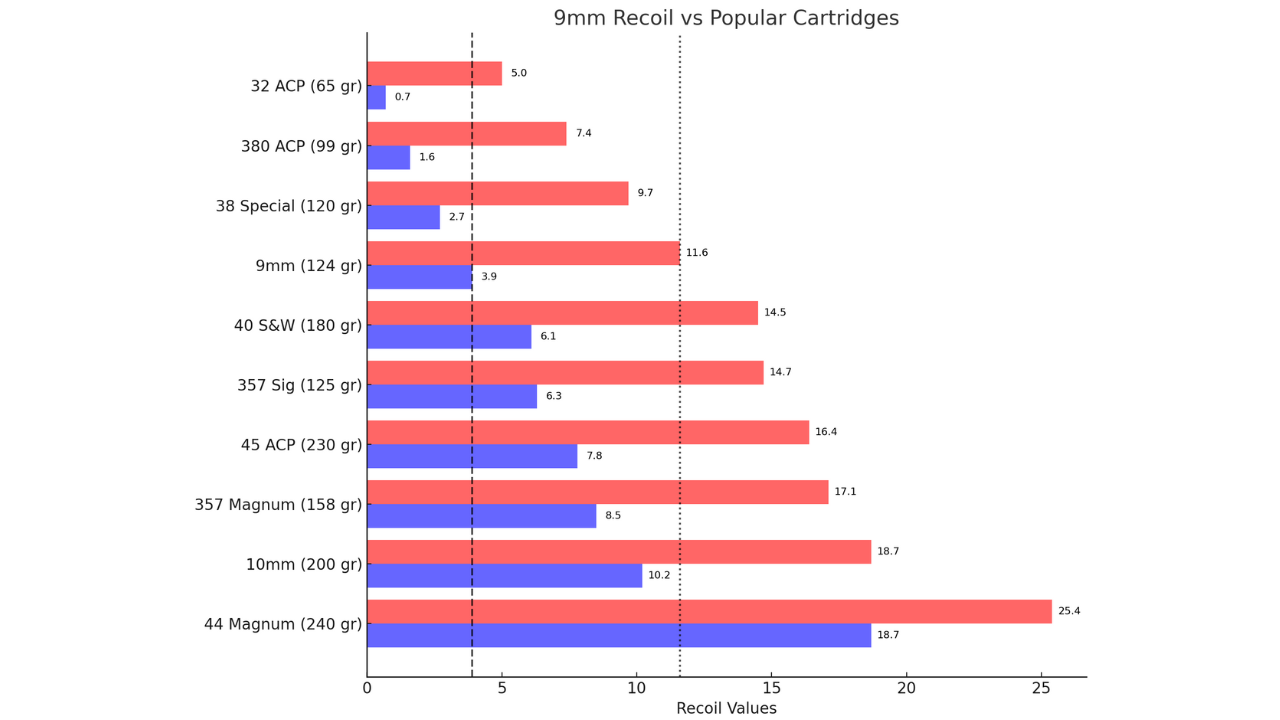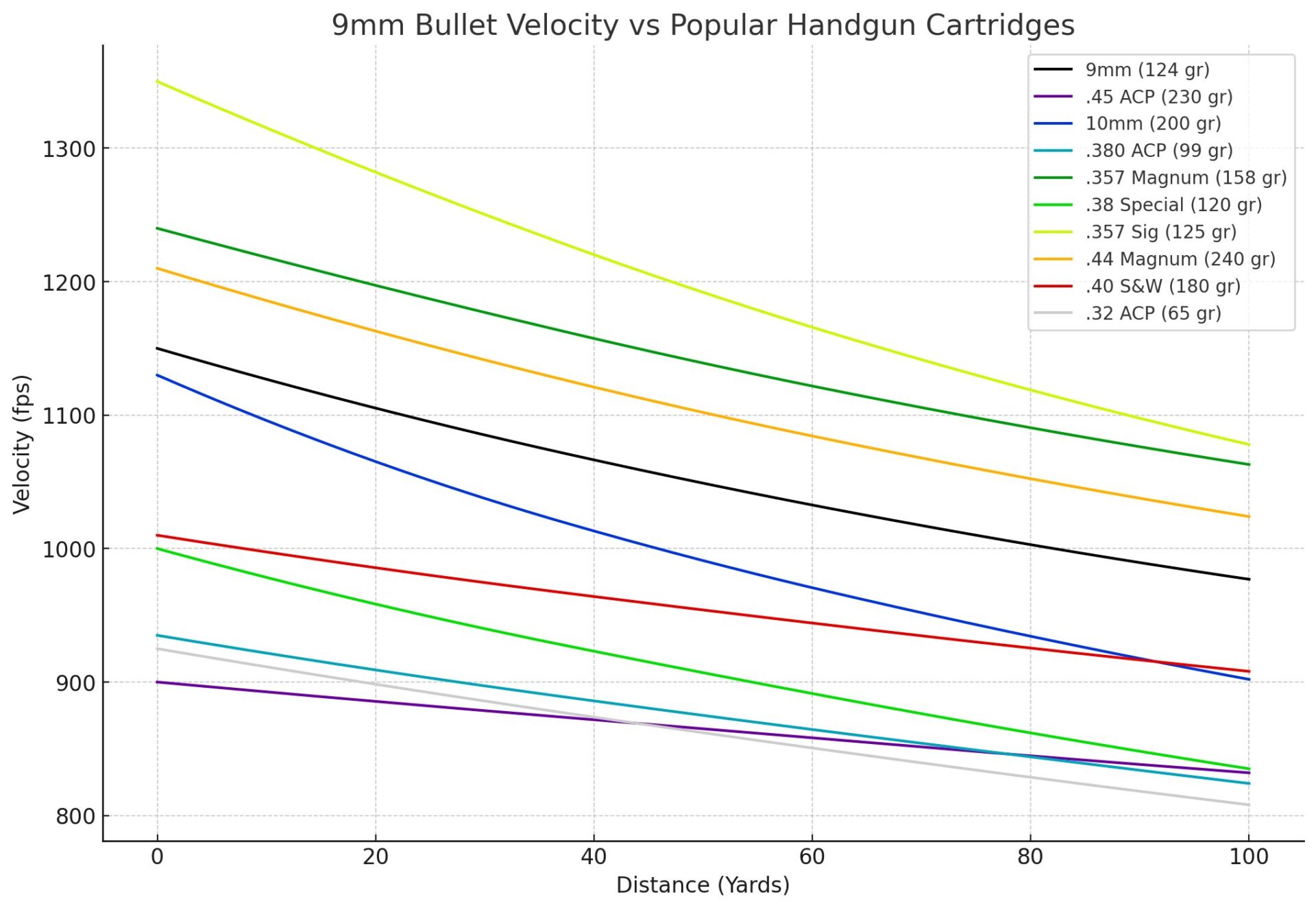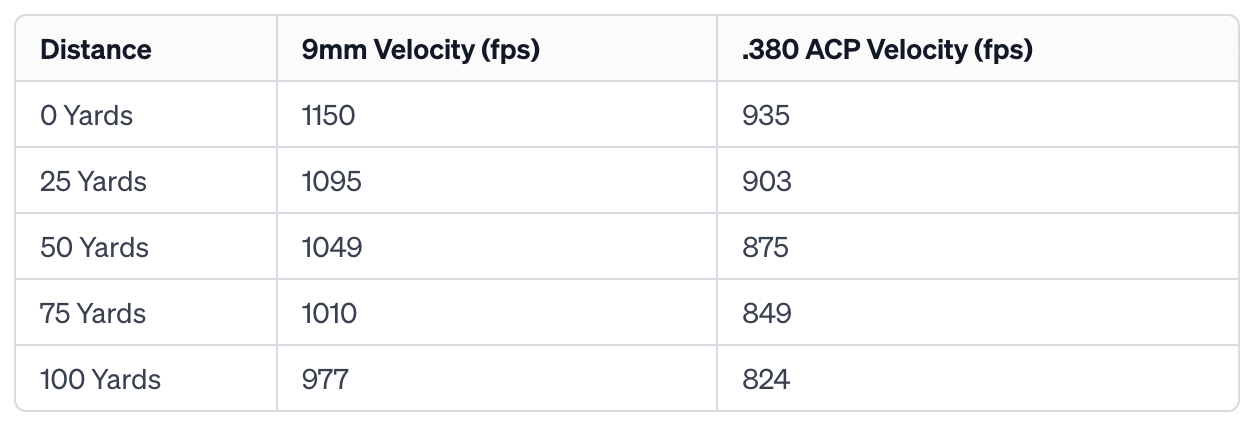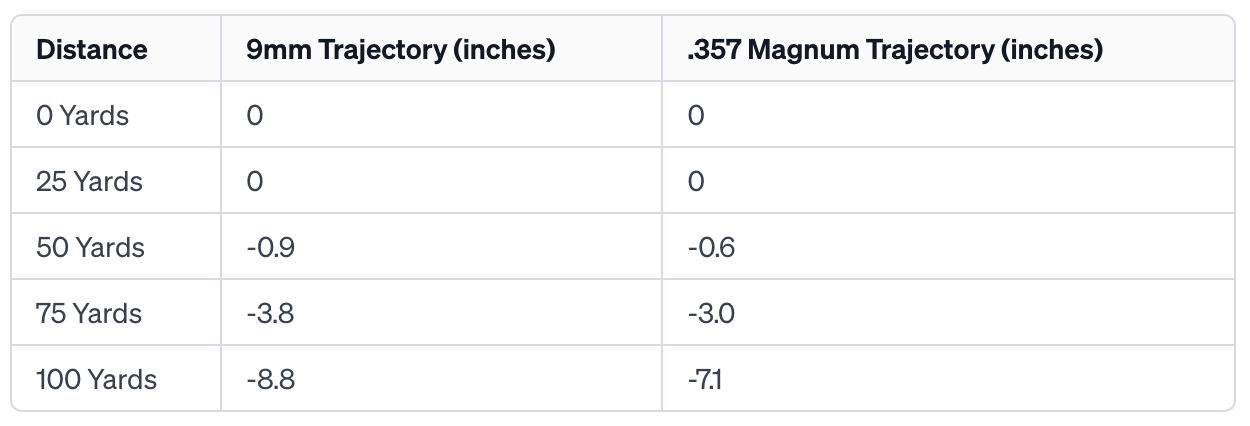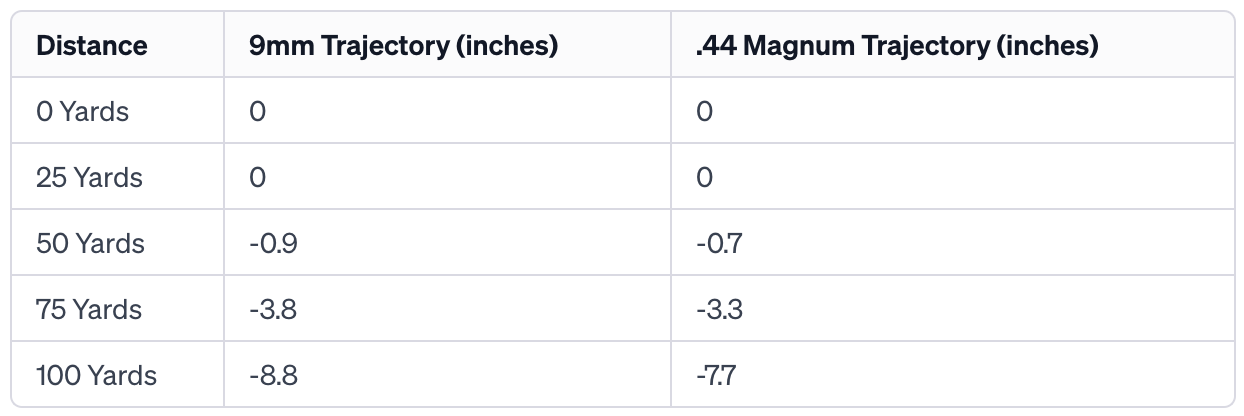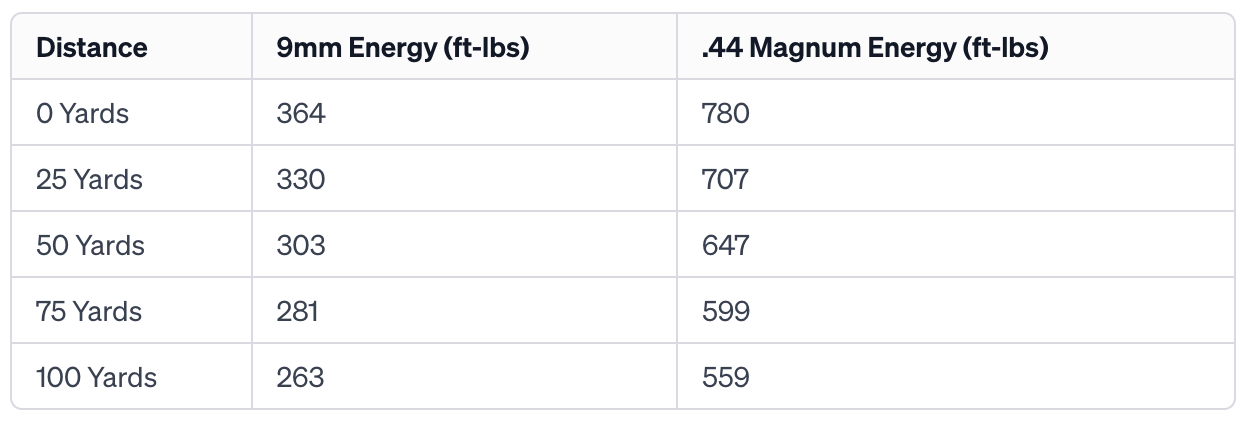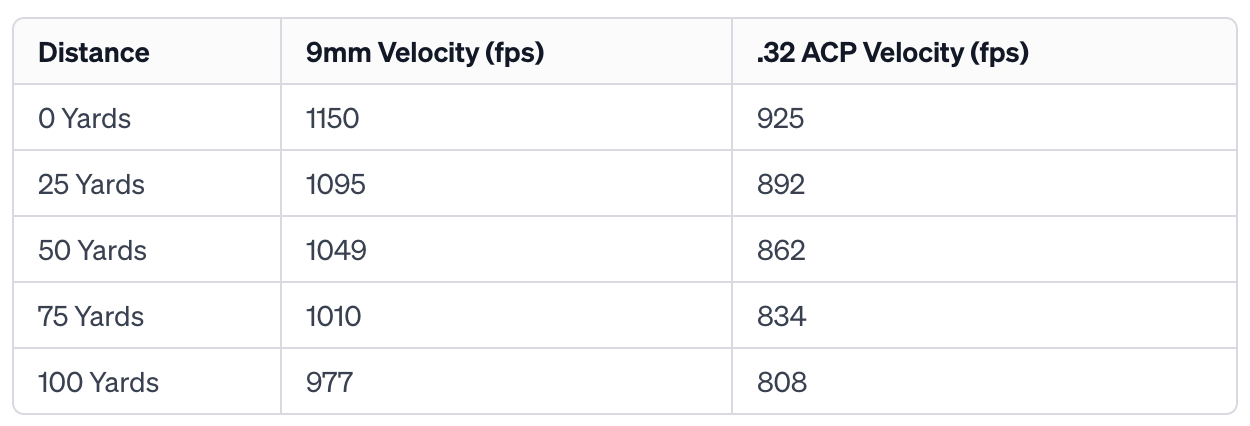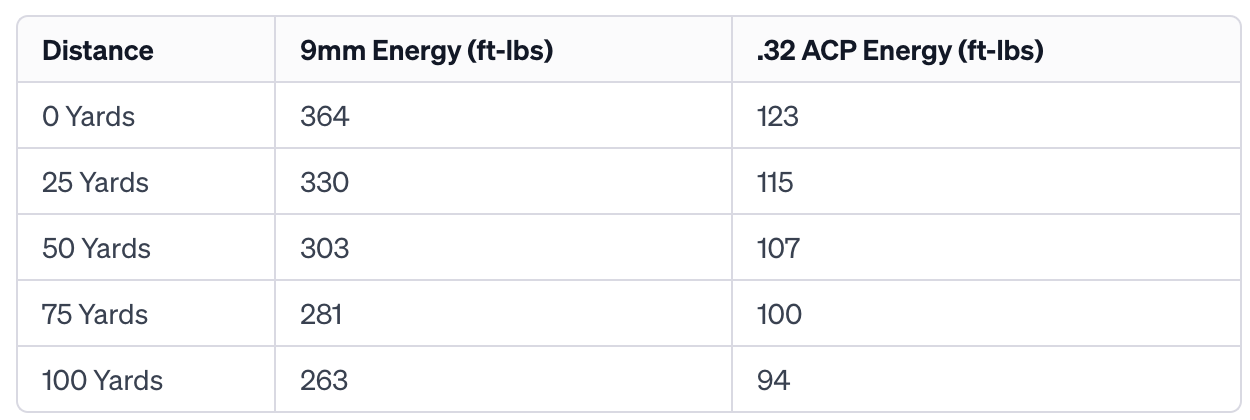Let’s explore the 9mm vs 9 popular handgun cartridges using ballistic tables and graphs out to 100 yards. The 9mm’s velocity, trajectory, energy, and recoil are compared to all 9 cartridges providing a clear and data-driven perspective on how the 9mm stacks up.
When it comes to handgun ammunition, the 9mm cartridge stands out as a favorite among shooters. It’s known for its balance of power, ammo capacity, and ease of handling, the 9mm has become a staple in personal defense, law enforcement, and competitive shooting. But how does it stack up against other popular rounds like the .45 ACP, 10mm, .380 ACP, .357 Magnum, .38 Special, .357 Sig, .44 Magnum, .40 S&W, and .32 ACP? Let’s find out.
Table of Contents
How To Use This Article:
I used common bullets for the cartridges in this article for a realistic comparison. In the graphs and tables, I make sure to show the grain of each bullet for simple comparisons. All of the bullets in this article were made for self-defense.
The Ballistic Tables
If you want a 1-on-1 comparison from 0 to 100 yards in 25-yard increments for any of these cartridges to the 9mm, you can find that after the graphs in the ballistic tables section.
The Ballistic Graphs
Keep in mind that with different bullet grains and different ammunition, you can achieve different results than shown below. However, you can use the information below to determine the potential of each cartridge.
Let’s jump into the graphs first because they’ll answer your broader questions faster.
Velocity Ballistic Comparison Graph: 9mm vs Popular Cartridges
Below are velocity ballistic graphs of all 10 cartridges. The 9mm is shown as a black line in all graphs.
Trajectory Ballistic Comparison Graph: 9mm vs Popular Cartridges
Below are trajectory ballistic graphs of all 10 cartridges. The 9mm is shown as a black line in all graphs.
Bullet Energy (Stopping Power) Ballistic Comparison Graph: 9mm vs Popular Cartridges
Below are bullet energy or stopping power ballistic graphs of all 10 cartridges. The 9mm is shown as a black line in all graphs.
Recoil Comparison Graph: 9mm vs Popular Cartridges
Below are the recoil values of all 10 cartridges. The 9mm recoil energy and recoil velocity are shown as dotted black lines for easy comparison to the other cartridges. This graph assumes that all cartridges are shot out of a handgun that weighs 30oz. This was done to create a better apples-to-apples comparison between cartridges.
Ballistic Tables: 9mm vs Popular Cartridges
9mm vs 45 ACP
Velocity
Trajectory
Energy
Recoil

9mm vs 10mm
Velocity
Trajectory
Energy
The 10mm (200 gr) consistently exhibits significantly higher bullet energy than the 9mm (124 gr) at all distances from 0 to 100 yards. While the 9mm starts with an energy of 364 ft-lbs at the muzzle, the 10mm begins with a substantially higher energy of 567 ft-lbs. This higher energy level for the 10mm remains across all distances, demonstrating 361 ft-lbs at 100 yards compared to the 9mm’s 263 ft-lbs. The larger powder load and heavier bullet of the 10mm contribute to its greater energy, making it more powerful on impact, especially at closer ranges.
Recoil

9mm vs 380
Velocity
Trajectory
Energy
Recoil

9mm vs 357 Magnum
Velocity
Trajectory
Energy
Recoil

9mm vs 38 Special
Velocity
Trajectory
Energy
Recoil

9mm vs 357 Sig
Velocity
Trajectory
Energy
Recoil

9mm vs 44 Magnum
Velocity
The .44 Magnum (240 gr) is almost double the weight of the 9mm (124 gr) yet still is has faster velocities at all distances from 0 to 100 yards. The .44 Magnum starts with a velocity of 1210 fps at the muzzle, compared to the 9mm’s 1150 fps. Despite its larger and heavier bullet, the .44 Magnum maintains higher velocities across the measured distances, suggesting superior ballistic performance, especially in terms of speed.
Trajectory
The 9mm (124 gr) and the .44 Magnum (240 gr) have similar trajectories, but the .44 Magnum shows slightly less bullet drop at longer distances. The 9mm experiences a drop of -8.8 inches at 100 yards, while the .44 Magnum drops about -7.7 inches at the same distance. Both cartridges exhibit relatively flat trajectories, but the .44 Magnum’s higher velocity contributes to its slightly better performance in maintaining a flatter trajectory over distance.
Energy
The .44 Magnum (240 gr) significantly outperforms the 9mm (124 gr) in terms of bullet energy at all distances. At the muzzle, the .44 Magnum starts with a remarkable energy of 780 ft-lbs, much higher than the 9mm’s 364 ft-lbs. This high energy level of the .44 Magnum is consistent across all distances, maintaining a substantial lead over the 9mm, with 559 ft-lbs at 100 yards compared to the 9mm’s 263 ft-lbs. The .44 Magnum’s higher energy can be attributed to its big and heavy bullet that moves at high velocity resulting in a lot of power.
Recoil

9mm vs 40 S&W
Velocity
The 9mm (124 gr) generally has higher velocities than the .40 S&W (180 gr) across all distances from 0 to 100 yards. The 9mm starts with a muzzle velocity of 1150 fps, compared to 1010 fps for the .40 S&W. This trend of the 9mm maintaining higher velocity continues through each distance, indicating its superior speed and potential for a flatter trajectory over distance.
Trajectory
The 9mm (124 gr) experiences less bullet drop compared to the .40 S&W (180 gr) at distances up to 100 yards. The 9mm shows a bullet drop of -8.8 inches at 100 yards, while the .40 S&W has a drop of -11.4 inches at the same distance. This indicates a relatively flatter trajectory for the 9mm, which can benefit accuracy.
Energy
The .40 S&W (180 gr) typically exhibits slightly higher bullet energy than the 9mm (124 gr) at all distances from 0 to 100 yards. The .40 S&W starts with an energy of 408 ft-lbs at the muzzle, slightly higher than the 9mm’s 364 ft-lbs. This trend of higher energy in the .40 S&W continues across distances, albeit the difference is not as pronounced as with larger calibers like the .44 Magnum.
Recoil

9mm vs 32 ACP
Velocity
The 9mm (124 gr) consistently exhibits higher velocities than the .32 ACP (65 gr) across all distances from 0 to 100 yards. It starts with a muzzle velocity of 1150 fps, while the .32 ACP begins at 925 fps. The 9mm maintains this velocity advantage throughout the range, demonstrating superior speed.
Trajectory
The 9mm (124 gr) experiences less bullet drop compared to the .32 ACP (65 gr) at distances up to 100 yards. The 9mm shows a trajectory drop of -8.8 inches at 100 yards, whereas the .32 ACP experiences a more significant drop of -14.5 inches at the same distance. This indicates that the 9mm maintains a flatter trajectory over longer distances which increases accuracy.
Energy
The 9mm (124 gr) has higher bullet energy than the .32 ACP (65 gr) at all measured distances. The 9mm starts with 364 ft-lbs of energy at the muzzle, in contrast to the .32 ACP’s 123 ft-lbs. As the distance increases, the 9mm continues to outperform the .32 ACP in terms of energy, with 263 ft-lbs at 100 yards compared to the .32 ACP’s 94 ft-lbs. The higher energy of the 9mm is a result of its greater velocity and heavier bullet.
Recoil

Final Thoughts: 9mm vs Popular Cartridges
As we’ve seen through our comprehensive comparisons, the 9mm (124 gr) cartridge holds its own as a well-rounded choice in the diverse world of handgun ammunition. Its balance of, velocity, bullet size, and power, make it a comfortable and reliable option for personal defense. In terms of energy, while the 9mm doesn’t always lead the pack, especially against powerhouses like the .44 Magnum and 10mm, it still delivers sufficient stopping power for human-to-human defense.
One of the standout features of the 9mm is its manageable recoil, which stands in stark contrast to more powerful cartridges like the .357 Magnum and .40 S&W. This lower recoil not only makes the 9mm accessible to a wider range of shooters but also facilitates quicker, more accurate follow-up shots, a critical factor in both self-defense and competitive shooting.
While cartridges like the .45 ACP and .380 ACP have their niches, the 9mm’s balance of power, capacity, and ease of handling keeps it at the forefront of firearm choices. Whether for law enforcement, self-defense, or sports shooting, the 9mm’s versatility and effectiveness are undeniable. It’s a testament to why, after so many years, the 9mm continues to be a popular and trusted choice among handgun enthusiasts.
In the end, the best cartridge depends on individual needs and preferences. However, for those seeking a middle ground in power, precision, and usability, the 9mm emerges not just as a jack-of-all-trades, but as a master of many.

